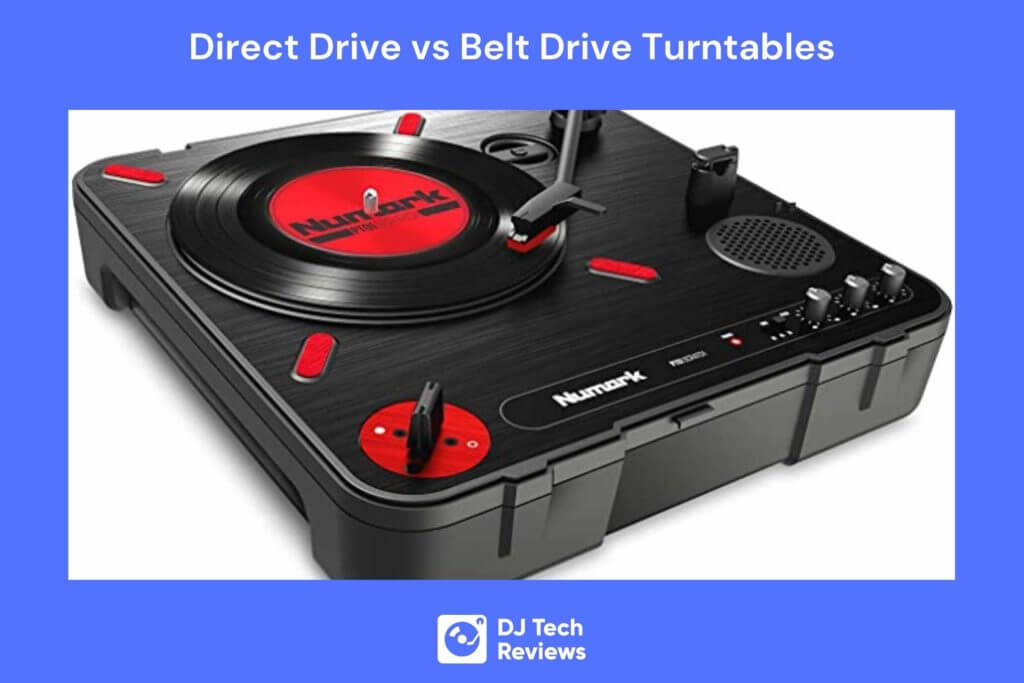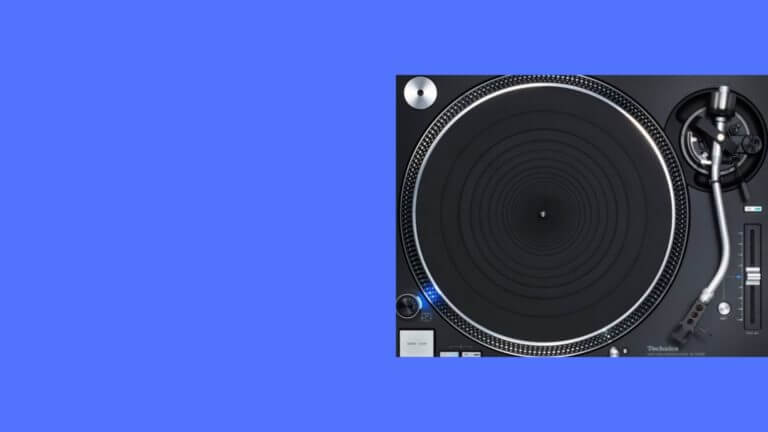One of the most well-known parts of a DJ’s setup is the turntable. Interestingly, while most people know about them, very few are aware of the direct Drive vs Belt Drive turntables discussion out there. Namely, the two more well-known types are the belt-drive and direct drive turntable. If you’ve ever thought about getting a set for your next performance, understanding the two options, and how they compare with one another, can be vitally important to make sure you pick the right one for you and what you need.
In this overview, we’ll go over both of these two options as well as break down their different pros and cons so that you can see which of the two will work best for you and your next DJ gig.
What Is A Direct Drive Turntable?
The direct-drive turntable holds the motor directly under the platter, as its name states, driving the turntable’s platter directly. Unlike belt-drive turntables, the direct-drive turntable can get up to speed almost instantly, while its platter is free from dealing with any potential resistance.
Because of these two factors, direct-drive turntables are consistently considered the ideal choice by DJs around the world. They can easily spin in either direction without damaging the motor. The direct-drive turntable also has a quick-start feature that turns the music on at the right pitch from the moment the stylus touches the record groove.
Direct-drive turntables also offer user speed control, making them an invaluable option for most DJs. If, as an example, you’re interested in changing up the tempo to blend one song into another, you can do so thanks to the range of speed adjustment offered.

What Is A Belt-Drive Turntable?
As the name implies, a belt-drive turntable is a turntable that uses a belt to spin its platter. This turntable typically has its motor found to the side of the device, with the belt wrapped around the turntable platter. This can range from sitting just outside on the edge of the platter itself, or around the outer edge of the inner platter where the outer platter sits.
The belt ensures that the motor can easily be isolated away from the platter. This can often lead to the table taking a few seconds before it can get up to full speed. Because the turntable is driven by a belt, it has a higher chance of wearing out and needing to be replaced at a fairly quick rate. The good news is that, while this is annoying, the process is fairly simple and inexpensive to do.

Comparing The Two – Which Is Better?
When compared to belt-drive turntables, the difference couldn’t be more apparent. While direct-drive turntables can generally start instantly and have several speed controls, belt-drive turntables can take several seconds to reach full speed and start playing.
As mentioned earlier above, because the belt is part of the mechanism itself, spinning the platter in any way will cause some wear and tear, eventually requiring it to be replaced. You’ll also note that, unlike the direct-driven turntable, which offered various speed control options, the belt-driven turntable option can only be changed to either 33 or 45 RPM.
While both have their respective strengths and weaknesses, if you’re a DJ, it becomes abundantly clear that the direct-drive model is the obvious choice to choose from. It can get up to speed faster (almost instantly), allows for complete spinning control, speed adjustments, and won’t break apart after a while.
Without a doubt, the direct-drive turntable is the better of the two options.
What If You’re Not A DJ?
For people that aren’t a DJ, it may seem, at first glance, that the results would still be the same. After all, what would be good for one should be good for the other, right?
Well, as it so happens, there are a few things that the direct-drive has that may hold it back when used by a casual music lover.
One such aspect is that, while DJs purchase a turntable to perform, non-DJs purchase turntables more to enjoy listening to music. Because of this, the direct drive may not be the best option. As an example, vinyl lovers care less about changing and mixing speeds and more about the highest quality of music, with a few sound distortions as possible.
As a result, belt-drive turntables can better isolate the platter from the motor due to their rubber belt. In addition, they are never quite fully connected to the turntable, instead of being slightly suspended. Other turntables are entirely separated from their motor. This is important as it means that there is a much lower chance that those that use a belt-driver turntable will have to deal with any noise distortions lowering or affecting the sound quality.
Another thing that is worth noting is that vinyl can more effectively draw you into the music. As such, a quality turntable will keep the pitch of the music high enough that it remains in that sweet spot.
Speed Consistency – Which Does It Better?
As you can see, both belts have their respective strengths and weaknesses. While belt-drives need to slowly build up before getting to the proper speed, direct drives can reach their optimal speed almost instantly. However, just because they can reach their speed doesn’t mean that they can inherently maintain it.
For the direct-drive, while it can increase in speed quite fast, for it to stay at that speed, it requires a lot of different circuitry to maintain it. Because of that, there is a constant correction happening with the turntable, much of which results in a sound that is not nearly as pitch-perfect as one would hope.
Conversely, the belt-drive has a much better speed consistency and stability, provided it is using a heavy platter. If properly weighted, once a platter does reach its ideal speed, it is much less likely to drift or create micro-changes. Even if it does slightly drift here or there over a period of time, the sound quality isn’t going to be affected nearly as much when compared to the direct drive turntable.

Which Is Actually Best For You?
Now that we’ve gone over the different variables behind both turntable options, it’s time to pick a winner.
For the direct-drive, there’s just no denying that it’s an incredible tool. This turntable can instantly reach its proper speeds while also having a ton of different speed adjustment options to choose from. The direct drive’s platter can be spun in any way without fear of damaging or wearing out any other pieces and can jump to the music’s sound immediately at the moment the stylus touches the groove. Simply put, if you’re a DJ, there is no better option for you.
Still, DJs aren’t the only people interested in turntables, contrary to popular belief. For those interested in high sound quality, it is the belt-drive that has more going for it. This turntable, while taking longer to get started, and running the risk of wearing out its belt, has a much cleaner and more impressive sound quality than the direct-drive turntable. It also can maintain its speed consistency for longer.
So, which is best for you?
While it is easy to just say “it all depends,” the reality is that it is dependent on if you want a turntable for your interest or professional use.
The Direct-drive turntable is ideal for DJs, as its sound quality is good enough while it can last longer without wearing at its structure. It also is perfect for DJs that love mixing and moving away from a sound only to jump right back into it. Even some of its less savory aspects, like its ever-shifting platters, are constantly being tweaked and modified, to the point where even these aspects are being fixed.
Simply put, if you are a working DJ and have the money to afford it, the Direct-Drive Turntable is the best bet for you.
For everyone else…
The reality is that, while the direct-drive is great for DJs, that’s all it’s great for.
The Belt-drive does have its fair share of problems, however, if you’re interested in quality sound, consistent speed, and an affordable, reasonable price tag, the belt-drive really can’t be beaten. Yes, you’ll have to deal with a belt break now and again, but this is a drop in the bucket compared to $5,000+ direct-drive turntables on the market today.
Simply put, while the direct drive is the best for DJs, the belt-drive is the best for everyone else and every other situation. If you are someone that enjoys quality sound that isn’t prohibitively expensive and works amazingly well, you are going to want to get the belt-driven turntable.
Direct Drive vs Belt Drive Turntables: Summary
When it comes down to it, both the belt and the direct-drive turntables are great in their way. Provided you know what you’re looking for and what you need the turntable for, either option is a great buy for their respective roles.
By understanding when to use which turntable, what its strengths and weaknesses are, and how it ultimately compares with its alternative, you can more confidently decide on what you want as well as how it will affect your overall listening or performing experience.




